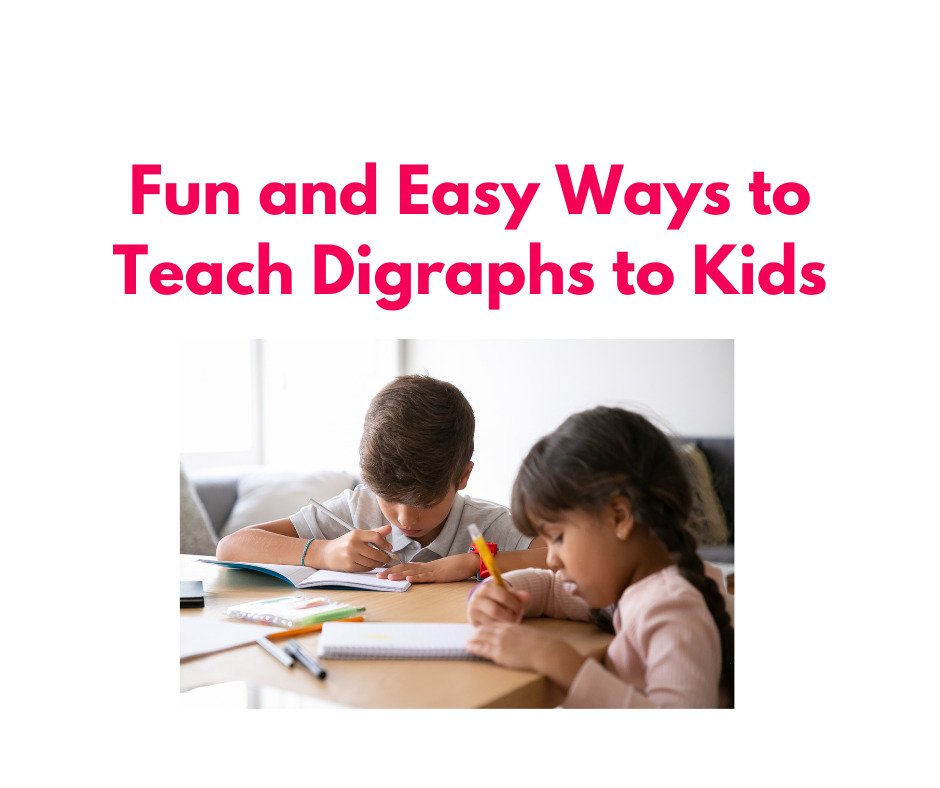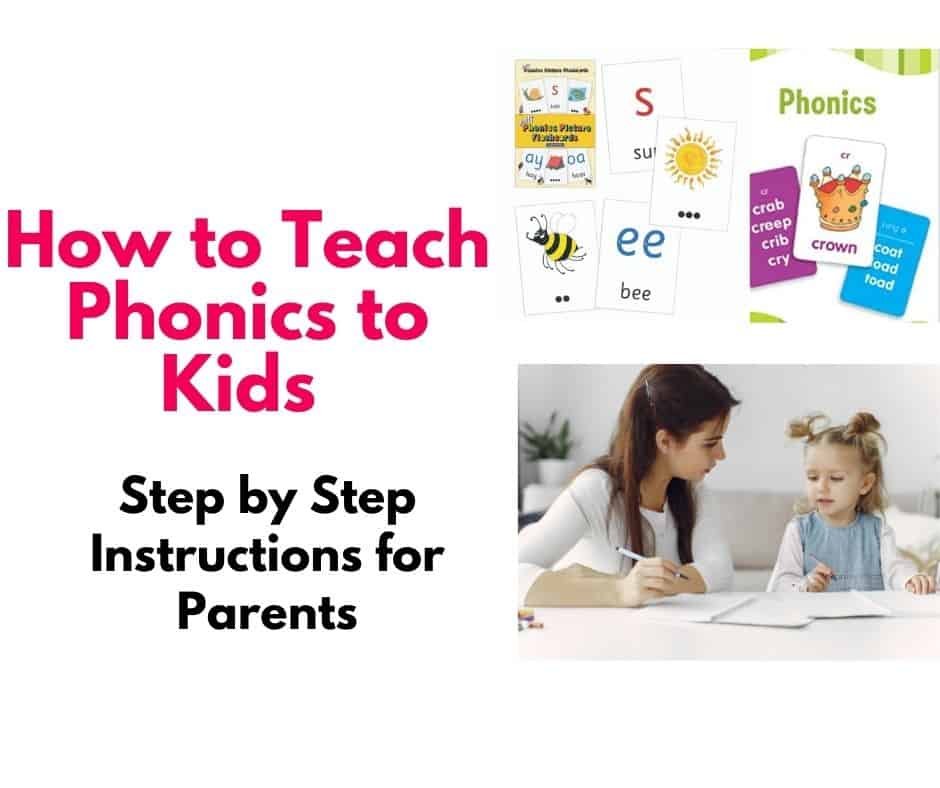
Looking for fun and effective ways to teach digraphs to kids? Look no further! Our article provides easy-to-follow tips and strategies that will help your kids unlock the power of two-letter sounds. Discover the secret code of sounds and make learning digraphs a fun and exciting adventure for your little ones.
I am happy to explain what digraphs are to parents who are interested in supporting their child’s literacy development.
Are you ready to uncover the secret code of sounds with your kids? Learning digraphs doesn’t have to be boring or frustrating. In fact, with the right approach, it can be a fun and exciting adventure for your little ones. Join us as we share some fun and easy ways to teach digraphs to kids and unlock the power of two-letter sounds.
Also Read – Top Strategies for Teaching Consonant Blends and Digraphs to Kids: A Comprehensive Guide
Get ready to become a digraph detective and discover the hidden gems of the English language! Let us start with the basics.
What is a digraph?
In phonics, a digraph is a pair of letters that together represent a single sound. This means that when two letters are put together, they make a new sound that is different from the sounds the individual letters make on their own.
Some common examples of digraphs include “sh”, “ch”, “th”, “wh”, “ph”, and “ck”. For example, the “sh” digraph in the word “ship” represents a single sound that is different from the sounds of the individual letters “s” and “h”.
Understanding and recognizing digraphs is an important part of learning to read and spell words accurately. By recognizing digraphs, children can more easily decode and read unfamiliar words, and also spell words correctly when writing.
Also read – How to teach CVC words to kids – fun ways that really work
What are the different types of digraphs?
There are two main types of digraphs: consonant digraphs and vowel digraphs.
Consonant digraphs:
Consonant digraphs are two consonant letters that come together to make a single sound. Some common examples of consonant digraphs include “sh”, “ch”, “th”, “ph”, “wh”, and “ck”. These digraphs are found at the beginning, middle, or end of words, and they often make sounds that are not represented by individual letters.
Vowel digraphs
Vowel digraphs are two vowel letters that come together to make a single sound. Some common examples of vowel digraphs include “ai”, “ea”, “ee”, “oa”, “ui”, and “ie”. These digraphs are found in the middle or at the end of words, and they often make long vowel sounds that are not represented by individual vowels.
It is important to note that digraphs are different from diphthongs, which are two vowel sounds that blend together to create a new sound, rather than a single sound created by two letters. Examples of diphthongs include “ou”, “ow”, “oi”, and “oy”.
List of words for consonant digraphs
Here is an exhaustive list of words for all 30 consonant digraphs:
- CH: beach, check, church, chimp, chop, coach, fetch, hitch, lunch, peach, speech, watch
- CK: back, black, brick, check, clock, duck, flick, lock, pick, sack, sick, stick, truck
- KN: know, knit, knickknack, knife, knoll, knock, knot
- NG: bang, bring, ding, fang, hang, king, long, lung, sing, wing, wrong, young
- PH: elephant, graph, phone, photograph, phantom, phase, phrase, physician
- SH: cash, dish, fish, hash, push, rush, shoe, ship, wish
- TH (voiced): breathe, father, leather, mother, soothe, weather
- TH (voiceless): bath, cloth, math, path, teeth, tenth
- WH: when, where, whisper, whistle, white
- WR: wrap, wreak, wreck, write, wrong
- BL: blackboard, blueberry, bubble, dribble, nibble, noble, stumble
- BR: break, breath, bright, broccoli, brown, brush, crab, grab, tribe
- FL: flag, flame, flap, flavor, flea, float, floor, flour, flower
- FR: frame, free, fresh, fridge, frog, from, fry, fruit
- GL: glad, glass, glee, glitter, globe, glue, glow
- GR: grass, green, grill, gross, growl, group, grunt
- PL: planet, plan, plant, plastic, play, please, plug, plum, plus
- PR: pray, press, price, pride, print, problem, product
- SC: scale, scare, school, scooter, scout, scissors, sculpture
- SH: cash, dish, fish, hash, push, rush, shoe, ship, wish
- SK: desk, disk, husk, mask, risk, whisk
- SL: slide, sleep, sleeve, slice, slight, slow, slug
- SM: small, smart, smell, smile, smoke, smooth
- SN: snack, sneaker, sniff, snore, snow, snuggle
- SP: space, sparkle, speak, spill, spin, spoon, spot, spring
- ST: stamp, stand, star, steal, stone, stop, story, street
- SW: swallow, sweat, sweep, swing, swiss, swoop
- TR: train, trap, tree, triangle, trophy, truck, trumpet
- TW: twin, twig, twist, twenty, twice
- WH: when, where, whisper, whistle, white
List of words for all vowel digraphs
Here is an exhaustive list of words for all vowel digraphs:
- ai: aid, aim, rain, pain, gain, chain, wait, paint, faint, train, snail, mail, sail, trail, wail, brain, main, plain
- ay: day, play, way, say, hay, may, pray, gray, clay, tray, sway, stay, bay, pay, lay, stray, array
- ee: see, tree, knee, meet, feet, sweet, seed, need, deed, feed, seek, week, peek, jeep, deep, sheep, sleep, sweep, steel, feel, heel, peel, reel, wheel, green, queen, keen, teen, mean
- ea: eat, meat, seat, beat, heat, neat, meat, feat, neat, seat, beat, heat, treat, great, sweat, lead, read, head, bread, dead, thread, spread, breath, death, wealth, stealth
- ie: tie, die, pie, lie, fried, tried, cried, tie-dye, untie, magpie, stymie, liege, fiery, untied, spiegeleisen
- oa: oak, coat, road, goat, soap, loaf, toad, roast, boast, croak, groan, moan, loan, foam, roam, hoarse, coarse, coax
- oe: toe, hoe, foe, woe, does, goes, shoes, foes, toed, foetal, roes, throe, boeotian, poet
- ue: cue, due, glue, blue, hue, sue, true, rescue, statue, value, argue, tongue, pursue, venue
- ui: suit, juice, build, guilt, suite, pursuit, nuisance, circuit, intuition, guitar, conduit, fruit
- ie: piece, field, shield, yield, thief, brief, chief, grief, pierce, niece, believe, reprieve, relieve, mischievous, liege, collie, goalie, untie, magpie, stymie
Note: It is important to keep in mind that some words may contain more than one digraph, and some words may contain digraphs that are not typically associated with that specific vowel digraph. Additionally, some words may have multiple pronunciations depending on the dialect or accent.
What are the signs your child is ready to learn Digraphs
there are certain signs that you can look out for to know if your child is ready to learn digraphs. One of the first things to consider is whether your child has mastered basic phonics skills, such as letter recognition, phonemic awareness, and decoding. If your child is able to blend and segment sounds to read and spell words, they may be ready to move on to digraphs.
Another sign to look for is whether your child is showing an interest in reading and writing. If they are constantly asking you to read books or trying to write their own stories, this could be a good indicator that they are ready to learn digraphs.
Additionally, you can also consider your child’s age and developmental stage. Generally, children between the ages of 5 and 7 are ready to learn digraphs, as they have typically developed the necessary phonics skills and cognitive abilities to understand the concept.
However, it is important to keep in mind that every child is different, and some may be ready to learn digraphs earlier or later than others. It’s always best to follow your child’s lead and work at a pace that is comfortable for them.
Also Read – How to Teach Phonics to Kids (Step by Step Instructions for Parents)
How do you explain digraphs to kids?
When explaining digraphs to kids, it’s important to keep it simple and use examples that they can easily understand. Here’s a simple way to explain digraphs to kids:
A digraph is when two letters come together to make one sound. So instead of making separate sounds for each letter, we blend them together to make a new sound. For example, in the word “ship,” the letters “s” and “h” come together to make the “sh” sound, which is different from the “s” sound and the “h” sound on their own.
You can also give kids examples of common digraphs, like “ch,” “sh,” and “th,” and practice saying words with those sounds together. You can use picture books or flashcards to help them see and recognize the digraphs in words. Encourage them to listen for and identify digraphs in words they see and hear in everyday life, like street signs or TV shows. As they practice more, they’ll become more comfortable and confident with using digraphs in their own reading and writing.
Comprehensive list of common consonant digraphs in English
here is a comprehensive list of common consonant digraphs in English:
- ch (as in chair, chop)
- sh (as in ship, show)
- th (as in thin, that)
- ph (as in phone, graph)
- wh (as in what, when)
- ck (as in back, clock)
- ng (as in ring, king)
- gh (as in ghost, laugh, rough)
- kn (as in know, knight)
- wr (as in write, wrap, wrong)
- gn (as in gnat, sign)
- mb (as in climb, thumb, comb)
- qu (as in queen, quick)
- sc (as in scissors, scene, scent)
- sk (as in skate, skip, skill)
- sl (as in sleep, slide, slow)
- sm (as in small, smile, smoke)
- sn (as in snack, snore, snow)
- sp (as in spell, spin, spot)
- st (as in step, stop, storm)
- sw (as in sweet, swim, swing)
- tw (as in twin, twig, twist)
- phth (as in phthisis, apthous)
- tch (as in watch, match, witch)
- dge (as in edge, bridge, judge)
- spl (as in splash, splay, splendid)
- spr (as in spring, spread, spray)
- str (as in string, strong, stripe)
- thr (as in three, throat, thread)
- shr (as in shred, shrink, shrimp)
It’s worth noting that there are some less common consonant digraphs as well, but these are the most frequently used ones in English.
Is there an order in which consonant digraphs are to be taught to kids
Yes, there is a recommended order for teaching consonant digraphs to kids based on their level of difficulty and frequency of use. Generally, it’s best to start with the most common and easiest digraphs and gradually progress to more complex ones. Here is a suggested order:
- ch
- sh
- th
- ck
- wh
- ph
- ng
- kn
- wr
- qu
- sc
- sk
- sl
- sm
- sn
- sp
- st
- sw
- tw
- tch
- dge
- spl
- spr
- str
- thr
- shr
- gh
- gn
- mb
- phth
This order is not set in stone and may vary depending on the individual needs and progress of the child. However, following this general order can help children learn and master consonant digraphs in a logical and efficient way.
How do you teach a consonant digraph for kids?
Here are some steps you can follow to teach a consonant digraph to kids:
- Introduce the digraph: Begin by explaining to the child what a digraph is and what it sounds like. Show them examples of words that contain the digraph and say the words aloud to demonstrate the sound. For example, when teaching the “sh” digraph, you can show words like “sheep,” “shoe,” and “shop.”
- Practice saying the digraph: Once the child is familiar with the digraph and the sound it makes, practice saying it aloud. Repeat the sound several times and encourage the child to say it with you. You can also have the child practice saying words that contain the digraph.
- Reading practice: Provide the child with reading materials that contain the digraph, such as books, flashcards, or worksheets. Encourage them to identify the digraph in the words and read the words aloud.
- Writing practice: Have the child practice writing words that contain the digraph. This will help them to remember the sound and spelling of the digraph.
- Review and reinforcement: Continue to review and reinforce the digraph in various contexts, such as through games, songs, and activities. This will help the child to retain the information and use it in their reading and writing.
Remember to make learning fun and engaging for the child. By using a variety of activities and techniques, you can help them to master consonant digraphs and improve their reading skills.
Fun and engaging phonemic awareness activities to teach digraphs to kids
Are you looking for fun and engaging ways to teach digraphs to kids? Look no further than phonemic awareness activities! These activities focus on developing kids’ understanding of the sounds that make up words, including consonant digraphs. From games and puzzles to read-aloud books and writing prompts, there are endless opportunities to help kids master the use of digraphs in English words.
Get ready to discover some exciting phonemic awareness activities that will make learning digraphs a fun and memorable experience for kids.
Picture Sorts
This is a great activity for visual learners. You can use picture cards to sort words that contain digraphs into different categories. For example, you could have a “ch” pile, a “sh” pile, and a “th” pile. You can use free printable picture cards or make your own.
Mainly you need printable picture cards that includes for example 12 different digraphs with 6 pictures for each digraph, making a total of 72 picture cards which you can use for sorting.
Word Hunts
Word hunts are a simple and engaging activity that can be used to teach kids about digraphs. To play a word hunt, start by selecting a digraph to focus on. For example, you might choose the “ch” digraph. Then, provide a list of words that contain the digraph or have kids come up with their own words.
Once you have your list of words, challenge kids to find and circle all of the words on the list that contain the digraph you are focusing on. This can be done with a pen or pencil on a printed copy of the list, or by using a digital document that allows for highlighting or circling.
To make the activity more challenging, you can also have kids create their own word lists and challenge their peers to find the words that contain the digraph. This can be done in a group setting or as an individual challenge.
Bingo Games
Playing bingo is a fun way to reinforce digraph recognition. You can use printable bingo cards that feature pictures or words containing digraphs.
Puzzles
Puzzles are another hands-on activity that can be used to help kids recognize and spell words with digraphs. They are an excellent way to engage kids in a fun and interactive way, while also building their cognitive and problem-solving skills.
One way to incorporate puzzles into digraph instruction is to use digraph puzzle pieces. These puzzle pieces are designed to fit together to create words with specific digraphs. Kids can manipulate the pieces to create new words and practice recognizing and spelling words with digraphs.
Another option for using puzzles to teach digraphs is to create your own puzzle by writing digraphs on index cards or paper and cutting them into pieces. Kids can then put the pieces together to form words with digraphs. This activity can be easily customized to suit different skill levels and can be used with any digraphs you are focusing on.
Overall, puzzles are a fun and effective way to help kids recognize and spell words with digraphs. They provide a hands-on approach to learning that can be enjoyed by kids of all ages and skill levels.
Read-Alouds
Reading books that feature words with digraphs can help kids hear and recognize them in context. One product recommendation for digraph read-aloud books is this one. This book includes over 300 activities, including stories, poems, and games, that feature common digraphs.
Digraph Sorts
This activity involves sorting words with digraphs into different categories based on the specific digraph being studied.
Memory Games
Memory games are a great way to help kids learn digraphs while having fun at the same time. Memory games are also known as concentration games or matching games.
To play a memory game for learning digraphs, start by creating a set of cards that each feature a different digraph. For example, you might create cards with “sh”, “ch”, “th”, and “wh” on them. Make sure you have at least two cards for each digraph.
Once you have your cards ready, shuffle them and lay them out face down in a grid. Then, have kids take turns flipping over two cards at a time. If the two cards match, they get to keep the pair and take another turn. If the cards don’t match, they must be flipped back over and play passes to the next player.
As kids play the game, they will start to recognize and remember the different digraphs. They will also practice saying the digraph sounds out loud, which will help to strengthen their phonemic awareness skills.
Flashcards
Flashcards are a simple and versatile tool that can be used to teach kids about digraphs. To use flashcards for teaching digraphs, start by creating a set of cards that feature different digraphs, such as “ch”, “sh”, “th”, and “wh”. You can create your own flashcards using index cards or cardstock, or purchase a set of pre-made flashcards.
Once you have your flashcards ready, use them in a variety of ways to help kids learn about digraphs. Here are some ideas:
- Practice recognition: Show kids a flashcard and ask them to identify the digraph on the card. This can help them develop visual recognition skills for digraphs.
- Practice pronunciation: Say the digraph on a flashcard out loud and have kids repeat it after you. This can help kids develop proper pronunciation of digraph sounds.
- Practice spelling: Show kids a flashcard and have them spell a word that contains the digraph on the card. For example, if the card features “ch”, kids might spell “chair” or “cheese”.
- Play games: Use flashcards to play memory games, matching games, or other games that help kids practice recognizing and identifying digraphs.
One great product recommendation for flashcards is this one. This set includes 54 cards that feature common digraphs, as well as examples of words that contain each digraph. The cards are made from durable cardstock and come with a handy storage box.
Overall, flashcards are a simple and effective tool for teaching kids about digraphs. They can be used in a variety of ways to help kids develop phonemic awareness skills and reinforce their understanding of digraph sounds.
Read-Aloud Books
Reading books that contain words with digraphs can help kids hear and recognize them in context. One product recommendation for read-aloud books is this one. This book features several examples of digraphs, including “ch”, “th”, and “wh”.
Writing Activities
Writing activities can be a great way to help kids learn about digraphs. Here are some ideas for writing activities that focus on digraphs:
- Fill in the blanks: Create a sentence or short story that includes words with digraphs missing. For example, “The ____ held up the ____.” Kids can then fill in the blanks with the correct digraphs to complete the sentence.
- Create word lists: Have kids create lists of words that include a specific digraph, such as “sh”. This can help them practice recognizing and spelling words with that digraph.
- Write sentences: Ask kids to write their own sentences that include words with digraphs. This can help them practice using digraphs in context and reinforce their understanding of digraph sounds.
- Write stories: Encourage kids to write their own short stories that include words with digraphs. This can help them develop their creative writing skills while also reinforcing their understanding of digraph sounds.
- Word sorts: Have kids sort words with different digraphs into categories based on their sound. For example, they might sort words with “sh” and “ch” into separate categories.
One great product recommendation for writing activities focused on digraphs is this one. This book includes 180 days of phonics practice activities, including many that focus on digraphs. The activities are designed to be quick and easy to complete, making them perfect for use in the classroom or at home. The book also includes answer keys for easy checking.
Singing Songs
Singing songs that feature digraphs can help kids remember them more easily.
Singing songs can be a fun and effective way to help kids learn about digraphs. Here are some tips for using songs to teach digraphs:
- Choose songs that feature digraphs: Look for songs that include words with digraphs, such as “sh”, “ch”, or “th”. You can find many children’s songs that feature digraphs, or you can create your own.
- Sing the song together: Once you’ve chosen a song, sing it together with your child or students. Encourage them to listen for words that contain the digraphs and sing along with those words.
- Highlight the digraphs: As you sing the song, use visual aids to highlight the digraphs. For example, you might hold up a sign with the “sh” digraph on it when you sing a word like “shoe”.
- Practice singing the song: Encourage kids to practice singing the song on their own, paying attention to the words that include digraphs.
- Create a new song: Challenge kids to create their own songs that include words with digraphs. This can help them practice recognizing and spelling words with digraphs while also developing their creativity.
One great product recommendation for using songs to teach digraphs is this DVD set. This set includes several DVDs that feature catchy songs and animated characters that teach kids about different phonics concepts, including digraphs. The songs are designed to be engaging and fun, making them a great way to keep kids interested and motivated while they learn. The DVDs also include printable lyrics and activities to reinforce learning.
By incorporating these phonemic awareness activities and products into your teaching or parenting, you can help kids develop strong phonics skills and master the use of digraphs in English words. These activities are designed to be engaging and fun, which can make learning more enjoyable and effective for kids.
Here are most frequently asked questions from parents about teaching digraphs to kids:
What are some Do and dont when teaching digraphs to kids?
Here are some dos and don’ts to keep in mind when teaching digraphs to kids:
Do:
- Make it fun and engaging: Incorporate games, songs, and hands-on activities to keep your child interested and motivated.
- Be patient: Every child learns at their own pace, so don’t rush the process or get frustrated if your child doesn’t grasp the concept right away.
- Use a variety of resources: Try different books, flashcards, apps, and other tools to find what works best for your child’s learning style.
- Focus on phonemic awareness: Help your child understand the sounds of the digraphs and how they’re used in words.
- Celebrate progress: Encourage and praise your child’s efforts, even if they’re just starting to learn.
Don’t:
- Force it: Don’t push your child too hard or make them feel pressured to learn quickly. This can cause them to become disinterested or overwhelmed.
- Overcomplicate it: Avoid using overly complex language or concepts that are difficult for your child to understand.
- Rely solely on one method: Don’t rely on just one method of teaching digraphs, as every child learns differently. Mix it up with different resources and activities.
- Compare your child to others: Don’t compare your child’s progress to others or set unrealistic expectations. Remember that every child learns at their own pace.
By following these dos and don’ts, you can create a positive and effective learning environment for your child to master digraphs and other language skills.
At what age can kids start learning digraphs?
Children can start learning about digraphs as early as four or five years old, depending on their phonemic awareness development. At this age, they are likely already able to identify individual letter sounds, and can start to understand how certain letter combinations work together to create new sounds.
What are some fun and effective ways to teach digraphs to kids?
There are many fun and effective ways to teach digraphs to kids, including:
- Word hunts: Encouraging children to actively search for words that contain the digraph you are focusing on.
- Puzzles: Providing hands-on opportunities to recognize and spell words with digraphs.
- Flashcards: Using flashcards to practice identifying and reading words with digraphs.
- Memory game: Playing a memory game with digraph flashcards to reinforce recognition and memorization.
- Writing activities: Encouraging kids to practice writing words that contain digraphs.
- Singing songs: Using songs and rhymes to help kids remember the sounds and spellings of different digraphs.
How can I tell if my child is having difficulty learning digraphs?
If your child is struggling to learn digraphs, they may have trouble reading and spelling words that contain these letter combinations. You may notice that they are hesitant or unsure when sounding out words with digraphs, or that they consistently misspell certain words.
If you have concerns, it’s always a good idea to speak with your child’s teacher or a reading specialist to see if they would benefit from additional support or interventions.
What can I do to help my child who is struggling with digraphs?
There are several things you can do to help your child who is struggling with digraphs, including:
- Provide additional practice: Encourage your child to practice reading and writing words with digraphs regularly and provide plenty of opportunities for hands-on activities and games.
- Use visual aids: Consider using flashcards, puzzles, or other visual aids to help your child better understand digraphs.
- Seek support: Speak with your child’s teacher or a reading specialist for additional support and resources.
- Be patient and encouraging: Remember that learning to read and spell words with digraphs can be challenging for some children, and it’s important to remain patient and encouraging as they work to develop these skills.
What if my child is not interested in learning about digraphs?
If your child is not motivated to learn about digraphs, it may be helpful to find ways to connect this concept to their interests. For example, if your child loves animals, you could find stories or games that incorporate animal-themed words with digraphs. You could also try setting small goals and offering incentives to keep your child engaged and motivated.
Can I teach my child digraphs at home, or do I need a teacher or tutor?
You can definitely teach your child about digraphs at home! There are many resources available online and in books that can help you introduce this concept to your child. Additionally, many schools offer support and resources for parents who are interested in helping their children learn at home.
How long does it usually take for a child to learn about digraphs?
The amount of time it takes for a child to learn about digraphs can vary depending on their age, development, and learning style. Some children may pick up this concept quickly, while others may need more time and practice to feel comfortable with it. It’s important to be patient and supportive as your child learns, and to celebrate their progress along the way.
What are some common mistakes children make when learning about digraphs?
Some common mistakes children make when learning about digraphs include confusing similar-sounding digraphs (such as “ch” and “sh”), mispronouncing or omitting one of the sounds in a digraph (such as saying “thick” instead of “this”), or having difficulty recognizing digraphs in unfamiliar words. These mistakes are normal and can be corrected with practice and repetition.
In conclusion, teaching digraphs to kids can be a fun and rewarding experience. By incorporating a variety of activities and resources, you can help your child develop phonemic awareness and build a strong foundation for reading and language skills. Whether you’re playing games, doing writing activities, or singing songs, there are many ways to make learning about digraphs engaging and exciting. With patience, practice, and support, your child can master these important language concepts and become a confident and skilled reader.
I hope this guide on teaching digraphs to kids has been helpful for you! As a parent, I know how important it is to lay a strong foundation for our kids’ language and reading skills. It’s great to see that there are so many fun and engaging ways to teach digraphs to our little ones.
I encourage you to try out some of the activities and resources mentioned in this guide, such as word hunts, puzzles, flashcards, writing activities, and singing songs. You can also use educational products like this flashcard set or these games to make learning even more enjoyable for your child.
Remember, every child learns at their own pace, so be patient and provide plenty of encouragement and support. With consistency and practice, your child will soon master these important language concepts and become a confident and skilled reader.







